- Table of Content
- 1.Le Soleil et n...
- 2.Heads-up on SC...
- 3.Review of sola...
- 4.Review of geom...
- 5.PROBA2 Observa...
- 6.The Internatio...
- 7.Geomagnetic Ob...
- 8.The SIDC Space...
- 9.Action!
2. Heads-up on SC25
3. Review of solar activity
4. Review of geomagnetic activity
5. PROBA2 Observations (30 May 2022 - 5 Jun 2022)
6. The International Sunspot Index by SILSO
7. Geomagnetic Observations in Belgium (30 May 2022 - 5 Jun 2022)
8. The SIDC Space Weather Briefing
9. Action!
Le Soleil et nous, a popular book written by a scientist of the STCE
A�new�book on the Sun has just been published in French, and its author, Fr�d�ric Clette, is a researcher at the Royal Observatory of Belgium and the Solar-Terrestrial Centre of Excellence. Inspired by his career and his experience in popularising science, he presents us, in this book intended for�a wide�readership, a global�panorama�of the Sun, its multiple influences on our planet and�us, humans, as well as the new dangers it may�bring�for our�present�society.
An eclectic career dedicated to the Sun
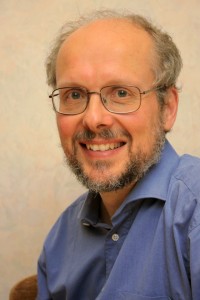
Fr�d�ric Clette has always been passionate about the stars, and it was with the ambition to study the starry sky as an astrophysicist that he began his studies in physics at the Universit� libre de�Bruxelles. But when he met Professor Andr� Koeckelenbergh, a solar physicist at the Observatory, his plans took a fully new direction. 'Suddenly,' says Fr�d�ric Clette, 'I realised that the Sun is an exciting subject in its own right, alongside the rest of the universe.'
A subject that he eventually explored in all its aspects throughout his career at the Observatory. He observed solar eclipses and participated in the SOHO space mission, and in the operations of its�EIT�telescope from NASA's control centre. He also took an interest in the Sun's radio signals captured at the Observatory's Humain station and was one of the first forecasters in the Observatory's space weather centre, set up in the early 2000s. Since 2011, he leads the�SILSO�world data centre, dedicated to the recording of sunspots and to the study of the long-term evolution of the 11-year solar cycle. This provides unique information for understanding the permanent role of our star on the Earth's climate at the scale of centuries.
A book project that came to life during the COVID lockdown
Although he decided to dedicate his career to the Sun, Fr�d�ric Clette did not abandon the other stars. 'I am still an amateur astronomer,' he confirms, 'and I still observe the night sky when the weather allows it. So I combine both sides: the Sun during the day, and the stars and planets at night.' He also likes to share his knowledge of the Sun, both with non-specialists during public lectures and with students via his course for the Master in astrophysics at the Universit� de�Li�ge, or also during guided tours of the solar dome at the Observatory in Uccle.
Based on the material gathered for these courses and lectures, he had long nourished the idea of writing a book about the Sun, a project that had 'remained on the back burner' due to a lack of time, given his demanding professional activities. When he was contacted by a Swiss publisher, Favre, in May 2020, just at the beginning of the COVID-19 pandemic, the opportunity presented itself. 'I thought: If I don't go for it now, it will never happen', he recalls.
The lockdown context required a certain determination: 'During the week, I was in front of a screen for work, and at the weekend, rather than taking time off, I was still alone in front of the screen, pushing my manuscript forward.'
The result is a book of nearly 500 pages of text and illustrations that is now available in bookshops throughout France, Belgium and Switzerland since 21 April 2022. The book is prefaced by Bertrand Piccard of the Solar Impulse Foundation, the initiator and pilot of the first fully solar-powered aeroplane that flew around the globe in 2016.
The dangers of a blackout: 'We must learn to live with the Sun'
Fr�d�ric Clette's 'Le Soleil et nous' ('The Sun and us' in English) not only presents, in a non-technical language, our latest knowledge about the structure and activity of our star. He also discusses ancient solar myths and deities, the Sun's role in the climate, and the links between the Sun and a wide variety of inexhaustible natural energies: light, heat, wind, biomass, etc.
Alongside the vital benefits of our star, he also mentions the new dangers that intense solar flares can pose to our society: the biggest ones can lead to communication blackouts, and global power outages in our electrical systems. Fr�d�ric Clette points out: 'Over the past few decades, our society has evolved in a way that makes us much more vulnerable to solar activity. Today, almost everything depends on electricity. We have created a global risk for ourselves that did not exist before.'
More than ever, citizens and political leaders need to know what the Sun is and what it brings to the Earth. We really need to learn to better adapt our activities, so that we can live in harmony with our star. What are the solutions to avoid a blackout?
According to Fr�d�ric Clette, one of the answers would be to decentralise electricity systems, in particular by migrating to renewable energies of solar origin. 'We can collect them everywhere on Earth, in different forms, even at home. Most of this energy is consumed locally, so it doesn't depend on long-distance electrical power lines, which are highly exposed to solar disturbances, and this would make our power supply more robust in the face of solar storms,' he explains.
A personal challenge and a unique experience for the author
Writing such a book proved to be a personal challenge and also a unique experience for the author. He says: 'When you start an article, you know that after one or two weeks the work will be completed. The end is already in sight. Writing a book, on the other hand, is a long odyssey into the unknown!'
Fr�d�ric Clette hopes that his book will later be translated into other languages. As for writing another such comprehensive book, it will not be for any time soon. He is nevertheless thinking of other projects, in particular a book more focused on a particular aspect of the Sun, or aimed at a more targeted audience, perhaps even children.
We are therefore waiting for the next book!
Reference:
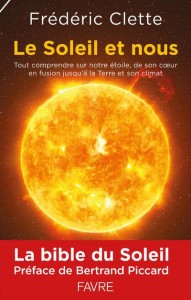
Fr�d�ric Clette
Le Soleil et nous�: Tout comprendre sur notre �toile, de son coeur en fusion jusqu'� la Terre et son climat.
Foreword of Bertrand Piccard
Publisher: �ditions Favre, Lausanne, Paris, 2022
EAN�: 9782828918910
Heads-up on SC25
The STCE's SC25 Tracking page (https://www.stce.be/content/sc25-tracking ) has been updated to reflect the latest evolution in some critical space weather parameters for the ongoing solar cycle 25 (SC25), from sunspot number all the way to cosmic rays. The multiple graphs allow for a comparison with previous solar cycles at similar stages in their evolution.
Over the last 4 months, solar activity continued to increase, with the southern solar hemisphere remaining slightly dominant. Six more X-class solar flares were recorded, as well as an important increase in the number of coronal mass ejections. An example of elevated solar activity can be found underneath (SDO/AIA 094, https://sdo.gsfc.nasa.gov/data/aiahmi/ ), when from 29 till 31 March, NOAA 12975 was the source of some important flaring events, including an X1.3 flare on 30 March.
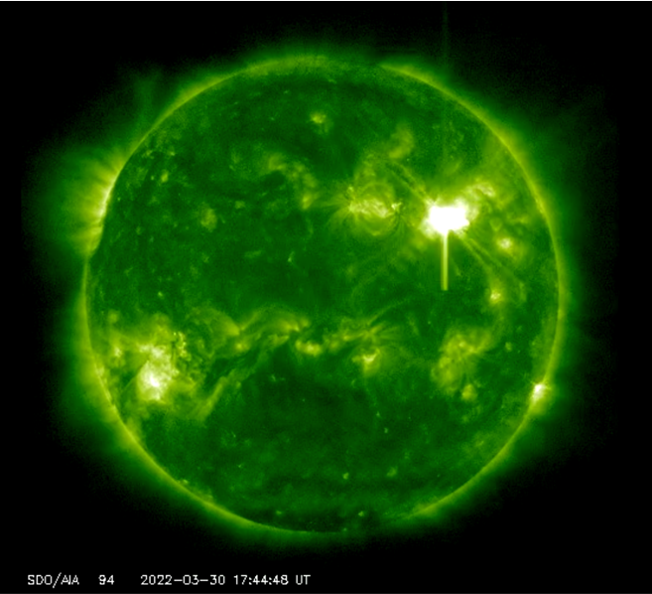
Sunspot activity continued its increase, with the smoothed monthly sunspot number currently about 35 percent higher than the values predicted by the international SC25 panel (updated 16 April 2021- https://www.spaceweather.com/). IF this trend continues, then SC25 maximum will be higher than expected. It remains to be seen if this maximum will be around 190 (+/-20) following the updated prediction by McIntosh and collaborators (2020 https://link.springer.com/article/10.1007/s11207-020-01723-y/ , update https://spaceweatherarchive.com/2022/02/25/the-termination-event-has-arrived/ ), or that it will still remain modest and comparable to e.g. SC20 which had a maximum of around 155, about 35 percent higher than the current prediction of 115 +/- 10 for SC25 (see https://www.swpc.noaa.gov/news/solar-cycle-25-forecast-update ). Indeed, also during the previous solar cycle, there was a first maximum from September to December 2011 with sunspot numbers around 120, before dropping to values well below 100. Nonetheless, for SC25, the sunspot numbers are expected to continue to increase over the coming months, as absolute monthly values are still below 100 (May 2022) and smoothed values near 50 (November 2021) only.
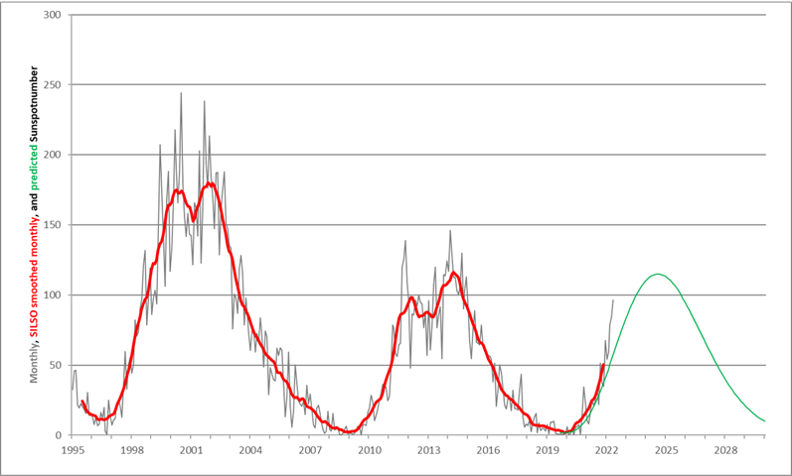
Review of solar activity
Three active regions were present on the side of the sun facing Earth at the start of the week: NOAA ARs 2023, 2024 and 2025. On 2 June, NOAA ARs 3026 emerged and 3027 rotated into view from the east limb. Two days later, NOAA ARs 2028 and 2029 rotated into view. All the mentioned regions had relatively simple magnetic field configurations (alpha and beta) and only produced two minor C-class flares (on 2 and 5 June).
A filament erupted on June 2 resulting in a wide Coronal Mass Ejection (CME) with the bulk of the material traveling to the west. The CME was thought to have an Earth directed component that could possibly arrive June 5.
A filament in the northern hemisphere erupted and resulted also in a CME which became visible on 4 June. The CME had an Earth directed component. A glancing blow at the Earth was possible on 7-8 July, although with a low probability.
The greater than 10 MeV proton flux was at nominal level. The greater than 2 MeV electron was most of the week slightly above the 1000 pfu threshold, it decreased below it on 5 June. The electron fluence was at moderate levels.
Review of geomagnetic activity
Earth was under the influence of a high speed stream (HSS) at the beginning of the week, with speeds close to 600 km/s. The effect of the HSS started to fade on 1 June, the solar wind speed became very slow (less than 300 km/s) by 4 June, and stayed so until the end of the week. The CME from 2 June mentioned above was slowed down considerably by this very low background solar wind speed, and it arrived only on 6 June (more than 24 hours after the expected arrival time).
Geomagnetic activity was quiet to unsettled throughout the week (K and Kp up to 3).
PROBA2 Observations (30 May 2022 - 5 Jun 2022)
Solar Activity
Solar flare activity fluctuated from very low to low during the week.
In order to view the activity of this week in more detail, we suggest to go to the following website from which all the daily (normal and difference) movies can be accessed: https://proba2.oma.be/ssa
This page also lists the recorded flaring events.
A weekly overview movie can be found here (SWAP week 636). https://proba2.oma.be/swap/data/mpg/movies/weekly_movies/weekly_movie_2022_05_30.mp4
Details about some of this week's events can be found further below.
If any of the linked movies are unavailable they can be found in the P2SC movie repository here https://proba2.oma.be/swap/data/mpg/movies/
Thursday Jun 02
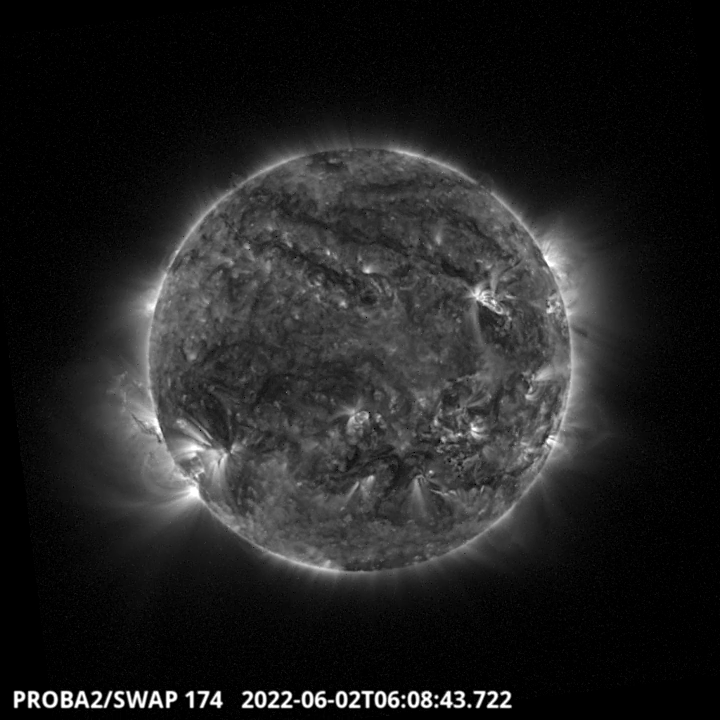
Saturday Jun 04
A prominence eruption on the South-East limb is visible around 6:08 UT on the SWAP image
above. Find a movie of the events here https://proba2.oma.be/swap/data/mpg/movies/20220602_swap_movie.mp4
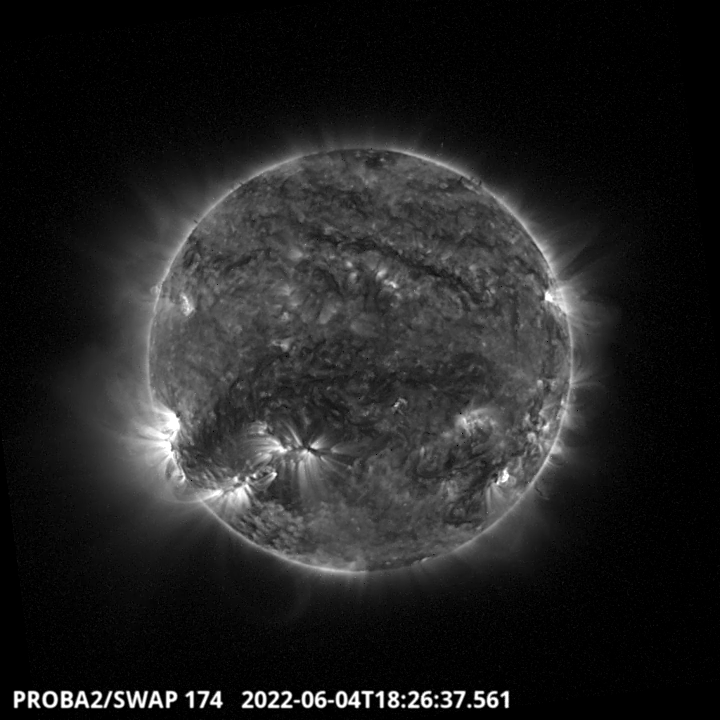
A prominence eruption on the South-West limb is visible around 18:27 UT on the SWAP image
above. Find a movie of the events here https://proba2.oma.be/swap/data/mpg/movies/20220604_swap_movie.mp4
Sunday June 5
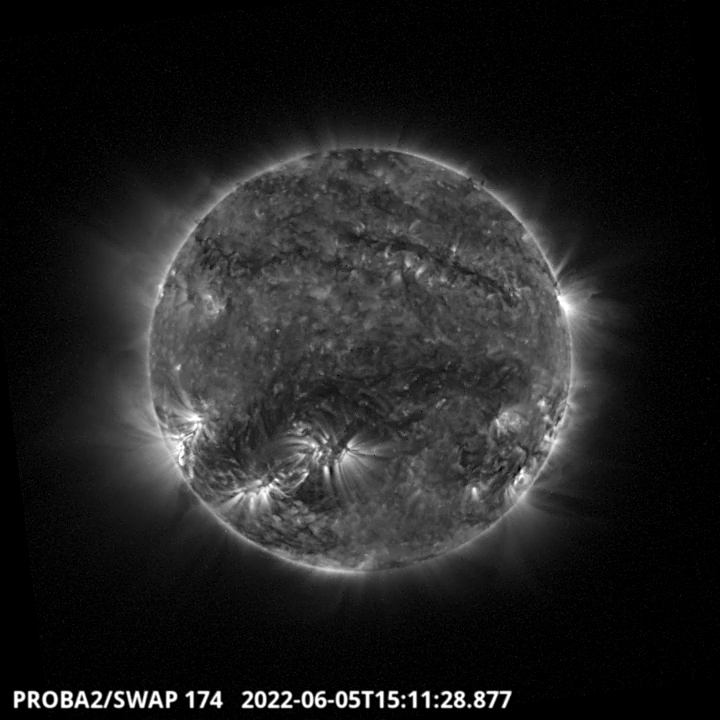
A filament eruption on the South-West part of the solar disk is visible around 15:11 UT on the
SWAP image above. It has been followed by a C class flare. Find a movie of the events here https://proba2.oma.be/swap/data/mpg/movies/20220605_swap_movie.mp4
The International Sunspot Index by SILSO
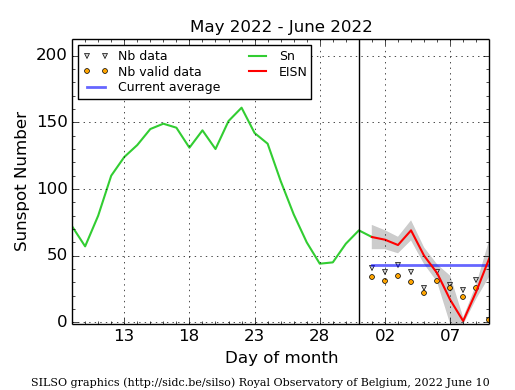
The daily Estimated International Sunspot Number (EISN, red curve with shaded error) derived by a simplified method from real-time data from the worldwide SILSO network. It extends the official Sunspot Number from the full processing of the preceding month (green line), a few days more than one solar rotation. The horizontal blue line shows the current monthly average. The yellow dots gives the number of stations that provided valid data. Valid data are used to calculate the EISN. The triangle gives the number of stations providing data. When a triangle and a yellow dot coincide, it means that all the data is used to calculate the EISN of that day.
Geomagnetic Observations in Belgium (30 May 2022 - 5 Jun 2022)
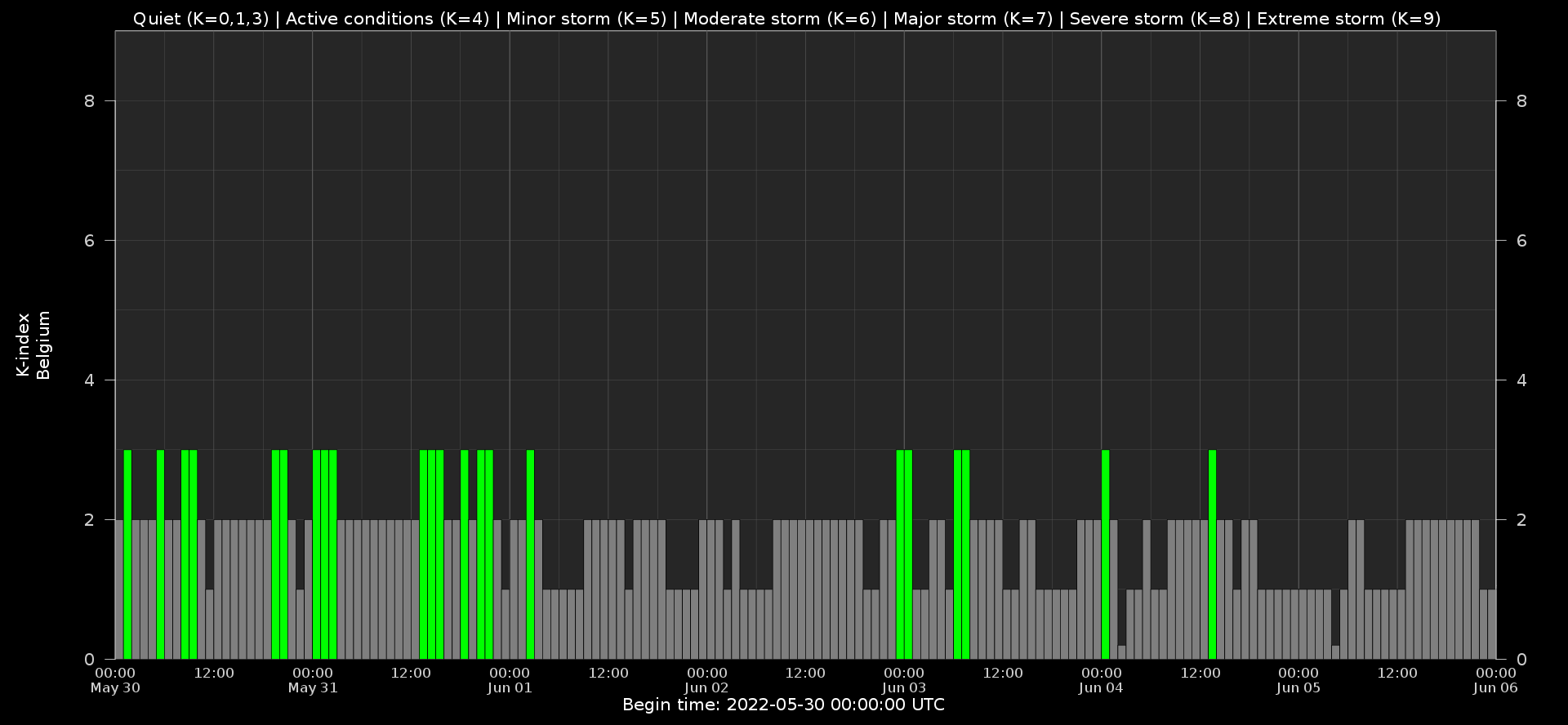
Local K-type magnetic activity index for Belgium based on data from Dourbes (DOU) and Manhay (MAB). Comparing the data from both measurement stations allows to reliably remove outliers from the magnetic data. At the same time the operational service availability is improved: whenever data from one observatory is not available, the single-station index obtained from the other can be used as a fallback system.
Both the two-station index and the single station indices are available here: http://ionosphere.meteo.be/geomagnetism/K_BEL/
The SIDC Space Weather Briefing
The Space Weather Briefing presented by the forecaster on duty from May 29 to Jun 5. It reflects in images and graphs what is written in the Solar and Geomagnetic Activity report.
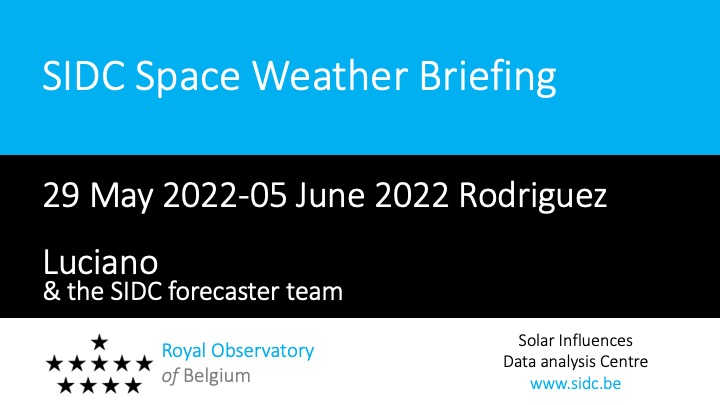
Pdf of the briefing: https://www.stce.be/briefings/20220606_SWbriefing.pdf
Action!
Check out our activity calendar: activities and encounters with the Sun-Space-Earth system and Space Weather as the main theme. We provide occasions to get submerged in our world through educational, informative and instructive activities.
If you want your event in our calendar, contact us: stce_coordination at stce.be
* June 10, RMI Seminar: Using machine learning in geophysical data assimilation, Brussels, Belgium
* June 13-15, Space Weather Introductory Course - onsite, by the STCE, Brussels, Belgium
* June 21, First Innovation day of PITHIA-NRF, Rome, Italy
* June 23, KU Leuven CmPA Seminar: COOLFluiD - High-Order Methods for Transitional Hypersonic Flow Modelling, Leuven, Belgium
* June 25, STCE at the Summer Space Festival, Brussels, Belgium
* July 3, Public Lecture on STCE's mission to the Sun, Cosmodrome, Genk, Belgium
* August 25, Public Lecture on Space Weather and Aviation, Astropolis, Oostende, Belgium
* October 24-28, 18th European Space Weather Week, Zagreb, Croatia
* November 21-23, Space Weather Introductory Course - onsite, by the STCE, Brussels, Belgium
* December 5, 6, 8, 9, Space Weather Introductory Course - online, by the STCE, zoom
Check: https://www.stce.be/calendar
